
Apple MacBook Pro M3 Max vs. Razer Blade 16
I’m pitting the best gaming laptop against the best productivity laptop and seeing who comes out on top. It’s a real sumo match of the big boys of the laptop world. No, not in bulk, but the highest-end Razer Blade 16 and MacBook Pros with M3 Max bill themselves as top-of-the-line laptops that thread the needle between portability and power. One’s billed for gaming, the other for high-end productivity, but both companies claim their PCs suit both.
Why compare a Windows gaming PC to Apple’s most powerful mainline laptop? These devices are ultra-premium, ultra-expensive laptops that promise to become your main means of on-the-go computing for many years after purchase. The M3 Max MacBook Pro 16 in my possession costs $4,000. My Razer Blade 16 with the new OLED, 240 Hz display, and Nvidia GeForce RTX 4090 GPU goes for $4,200 MSRP. They’re both hardy, aluminum-hulled behemoths, and since November of last year, they brought the new M3 Macbook Pro. Both have an anodized black finish that makes them resistant to fingerprints.
The Blade 16 may call itself a gaming device first and foremost. Still, it has enough under-the-hood performance to carry out some intensive rendering tasks that may turn the heads of any 3D modeling or video-producing professionals. On the other hand, the MacBook with an M3 Max chip is a productivity-first design. However, Apple has been expressly trying to court gamers with the latest version of macOS incorporating a “gaming mode” that increases framerates by limiting background tasks, similar to settings that already exist on Windows.
If you need one of the most capable work devices for intensive rendering or a ride-or-die Apple fan looking to burn cash, you’ve likely already made your buying decision. Suppose you’re a capital “G” gamer who only wants to fill their drive with as many titles on their Steam library as possible. In that case, you’re pretty set on the Blade 16 or perhaps other gaming laptops with the best possible specs available today.
But for those who are hanging on to several thousand dollars with the expectation they won’t need to buy another laptop for many, many years on, and for those who want a PC that can handle any tasks that you throw at it before popping it in your backpack and taking it on the go, this guide may provide help you avoid you end up tossing your wallet into the fires of bad purchasing decisions.
Plenty of quality options are available for those who could make do with slightly less power, most for less than $2,000. Those with a gaming fixation and limited budget might even try a few examples of the budget gaming laptops currently available for at or less than $1,000. If you want a productivity laptop, might we suggest looking at the slim, lightweight MacBook Air line or more recent PCs like the MSI Prestige 16 AI EVO?
MacBook Pro Vs. Razer Blade 16 Display and Design
OLED Still Beats Liquid Retina
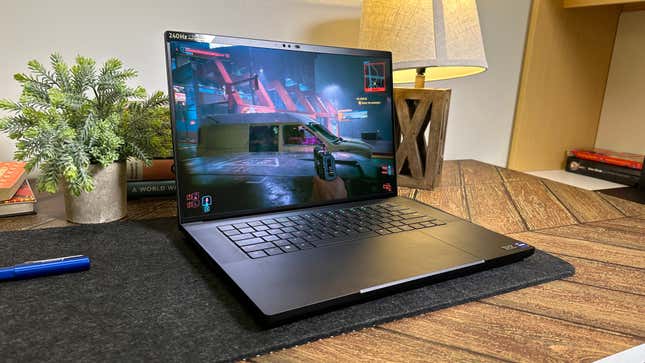
Both screens on the MacBook and Razer are deep and beautiful, but the Blade 16 takes the edge merely due to the deep contrast of OLED versus Apple’s displays. The new 2024 Blade sports a QHD+ resolution, 240 Hz OLED that hits all the marks of what I want from a modern, high-end screen. There’s no beating around the bush; it’s just a nice screen. The only complaint is the maximum brightness of 400 nits compared to the MacBook Pro’s stated 600 nits at SDR settings (and higher with HDR).
Last year’s Blade 16 model with the dual resolution and mini-LED display may cost slightly less than the 2024 edition, depending on where you buy it. However, the slight price bump may be worth it for what’s quickly becoming the new standard for high-quality displays, whether you’re a gamer or not.
Apple used the Liquid Retina XDR nomenclature to describe its screens, but in the end, they are still IPS LCDs. There’s nothing inherently wrong with that, and it’s still a quality display, but it misses out on the color contrast of OLED. Its max refresh rate is 120 Hz, which is still fair for most laptops, but some games can benefit from higher refresh rates. If you have one lying around, the laptop can support 240 Hz on an external monitor.
You have to have both laptops in hand to feel how similar the build quality is between Razer’s and Apple’s designs. They both use CNC aluminum, which at least feels durable. Both should avoid fingerprints and scratches, though I’ve found one blemish on my Razer that I suspect must have happened during packaging. However, what’s more important is the total size of each device. The Blade 16 weighs about 5.4 pounds compared to the MacBook Pro’s 4.8. If .6 pounds of difference matters to you, you should also consider how the MacBook is a more compact device overall. The MacBook Pro is .61 inches tall when folded up compared to the .86 Blade 16. Both still manage to slip nicely into a backpack’s laptop pouch, which, in the end, should be the end all, be all when it comes to overall dimensions.
The side speaker systems on both devices flank the low-profile keyboards and trackpad. The trackpad on the Blade is about .25 inches wider than Apple’s, though we’ll get into how they both feel and function in the “Usability” section. While both have similar size bezels around the screen, the MacBook Pro still uses the damn notch, which we still think is a pretty poor use of that space, considering iPhones like the iPhone 15 line now make use of the handy Dynamic Island.
But what may put the Razer over the edge here, beyond the screen, of course, is the number of ports on offer. The Razer has an HDMI 2.1, two USB-C (one Thunderbolt 4 and another USB 3.2), and three separate USB 3.2 Gen 2 Type-A alongside the full SD-card slot. The MacBook has plenty of USB-C connections but no USB-A. The Razer’s proprietary charging port is annoying since it can block off access to some cables, depending on its orientation. Still, I would rather have more options to plug in some of my other peripherals than scrounge for a USB-C to USB-A converter.
Winner: Razer Blade 16
MacBook Pro M3 Max Vs. Razer Blade 16 Performance and Gaming
Macs Still Aren’t the Place for Gaming
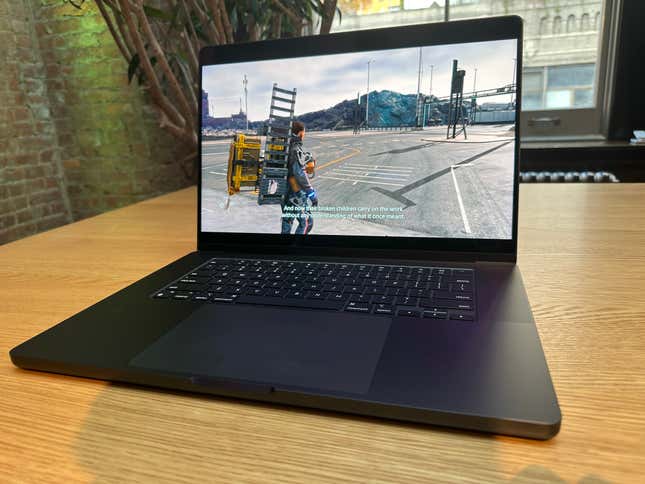
This is probably the most challenging category to judge, and it all has to do with Apple’s constrained ecosystem that still lacks access to some of the most popular titles of the last several years. The Cupertino, California tech giant has made several passing promises to become a new haven for gaming, pushing titles like last year’s Resident Evil 4 remake and Death Stranding: Director’s Cut at the start of this year. And yet, it’s still a pain in the posterior to play a lot of Windows-centric titles that those PC’s routinely enjoy.
The Blade 16 model I based my tests on was the version that came with 32 GB of RAM, an Nvidia GeForce RTX 4090 mobile GPU, and the standard 14th-Gen Intel Core i9-14900HX. That CPU is a 24-core (8 P and 16 E cores) at 5.80 GHz. It’s quite a hassle to compare that x86-based chip directly with the ARM-based APU contained within the M3 Max. That’s a 16-core CPU (up to 12 P cores with 4 E cores) with up to 40 cores of GPU. This version of the MacBook also sports 48 GB of RAM, which might tip the scales on a pure benchmark-to-benchmark comparison.
The MacBook Pro with M3 Max has the edge regarding anything CPU-related. In benchmarks like Geekbench 6 and Cinebench R24, the M3 Max chip beats the Intel Core i9, not by a few dozen points. The MacBook Pro, with the most high-end specs, doubles Blender’s benchmarks over the Razer Blade 16 on every metric.
But once you break into actual software, the Razer Blade shows how strong a dedicated GPU can be. With similar high settings across the MacBook M3 and Razer Blade 16, the Blade performed outstanding compared to its similarly-priced counterpart. I could break well over 160 FPS in interior areas in Baldur’s Gate III and still beat 80 FPS in crowded, open settings with the Blade. To compare, I could hit 130 FPS on high settings in wilderness settings and low 70s, or even lower, when on the Baldurian streets during Act 3.
The M3 Max Mac will struggle to hit high FPS on specific titles, whereas the Blade can push those to the limit with few tradeoffs. It’s obvious what the real use case of each laptop truly is. Apple would love the MacBook Pro to be your gaming unit, but it simply can’t be, not when it lacks access to many major games of the past few years. Still, it’s no slouch on performance for what is there. Spin back to the Razer Blade 16, and you have the opposite. It’s one of the best gaming laptops you can buy in terms of raw power, and while it’s no slouch for rendering tasks, it’s not the best. If you’re a sometimes 3D modeler and a full-time gamer, go with the Razer. If you’re the opposite, go with the MacBook Pro.
Verdict: Like most preteen relationships, it’s complicated
Razer Blade 16 Vs. MacBook Pro 16 M3 Max Battery Life
Apple Has the Edge on Longevity
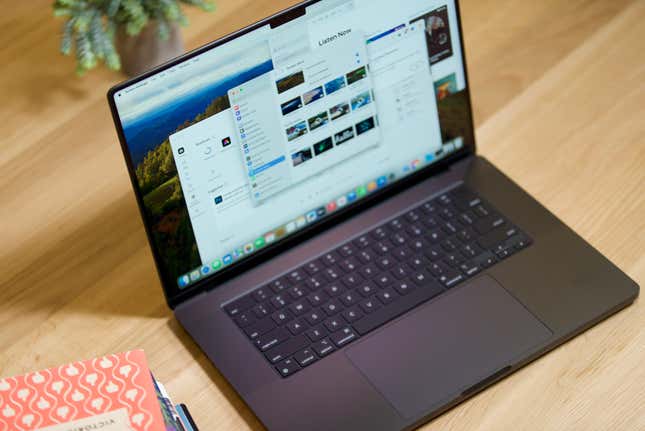
On average, I could work four to five hours on the Razer Blade 16 unplugged, doing simple browsing and work tasks. You can squeeze out an hour or two more with low-power settings. That’s a little better than many gaming laptops, but it’s not good enough for an entire workday without a plug. The 330W charging unit that comes in-box isn’t as massive as they come, but it’s still a chunky brick that will weigh down anybody on the go. It’s thick enough, but I would prefer to drag along something smaller, like a 45W brick, and plug it in through USB-C.
The M3 MacBook Pro will do the job for far longer. I’ve spent 8 hours on the M3 Max doing regular browsing and work tasks without seeing it drop below 30%. The power efficiency settings are good enough. You don’t have to flip any switches to eke out a few more minutes of juice, though the high power mode, best for gaming settings, will sap the battery nearly as fast as the Razer Blade.
Winner: MacBook Pro M3 Max
MacBook Pro M3 Max Vs. Razer Blade 16 Usability and Sound
The Razer Blade Needs a Better Keyboard and Trackpad
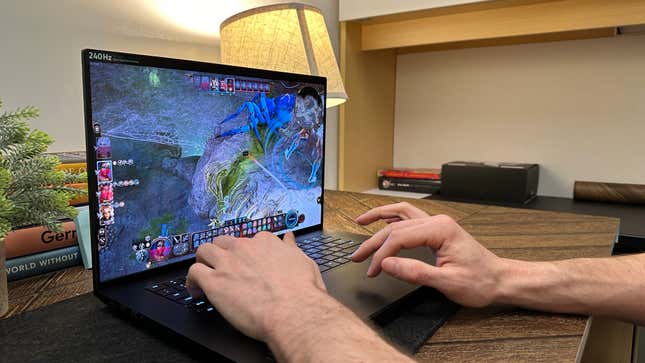
You don’t have to listen hard to hear the difference between MacBook Pro’s and the Blade’s sound quality. When reviewing it earlier this month, I considered the Blade’s speakers pretty strong, with bass that could fill a room and excuse the need for any sound bar or external speaker system. Yet, it does not compare to the MacBook Pro’s six-speaker system and force-canceling woofers. There’s an amazingly clear quality to the Pro’s sound, whether watching movies on Netflix or streaming nonsense on YouTube.
Apple sometimes gets too much credit for its focus on usability, but at the very least, you know you won’t curse out the company over its keyboard. What’s most striking about Razer’s ultimate, super high-end design is that the company has not put any mind toward folks who will end up typing and scrolling on their $4,200 laptop. The keyboard is a simple chicklet design with flashy LEDs underneath. This would be good enough on a budget PC, but it’s not even that strong a choice for most gamers.
Worse, by far, is the trackpad. The Blade 16 has such a problem with palm rejection that if you’re the typist who rests his forearms on the front, you will end up routinely clicking where you didn’t intend to while typing. I wrote half this review on the Blade and half on the MacBook Pro, and I would much rather type for any length of time on Apple’s high-end computer than try to wrestle with Razer’s awful trackpad.
That’s not to say the MacBook is any dream to type on. It’s really the same Magic Keyboard Apple’s used since the entirely earned demise of the butterfly keyboard. The low-profile mechanical keys have a slightly softer feel to the Razer Blade’s design, but neither offers any “oomph” that gives a tactile feel to your typing experience. The MacBook trackpad isn’t some miracle of design either, but it has much better palm rejection. If the choice were based merely on the ability to type on your laptop, the MacBook would win hands down.
The Winner: MacBook Pro M3.
MacBook Pro M3 Max Vs. Razer Blade 16 Verdict
Pick Your Poison
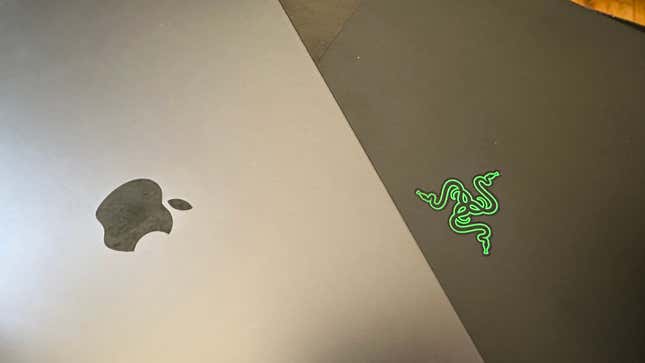
If anything, these tests show there’s still no all-in-one device that would be good for every kind of laptop power user. The M3 Max MacBook Pro is the most powerful device of this price point I’ve used, though that only accounts for non-gaming tasks. The Razer Blade 16 is a great gaming laptop, perhaps the epitome of high performance and price. It can accomplish other tasks but won’t be as easy or enjoyable as possible.
Both devices are splurges, but if you have a hankering to do anything other than gaming, the M3 Max MacBook Pro does the job. Its base control and sound quality beat the Razer Blade 16 despite being nearly equivalent in price. It can still play some games on high settings, but I wish Apple could finally confirm its plans to reach across and drag more developers onto its side of the walled garden. You could hook up with the folks on the r/macgaming subreddit for a few tips and tricks for getting some titles to work, but it’s a lot of work because you’re paying upwards of $3,000 for a single computer.
The Razer Blade plays games on high settings and a nice, beautiful, fast screen. It can run intensive programs better than most, but its keyboard and trackpad leave a lot to be desired. Take them for what they are, as these are two very different devices. It’s still too bad there’s not one laptop that’s been able to maximize everything, especially when companies expect you to pay thousands of dollars for them.
